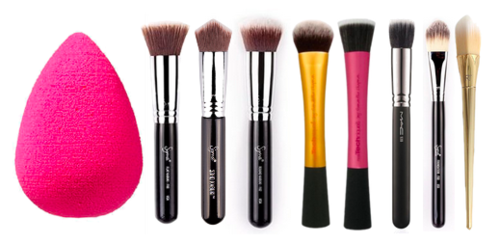
Battle of the tools! What coverage will one get from different applicators?
- BeautyBlender: The BB is great for all skin types, especially dry. It works great for dry skin because the BB helps cover dry patches well, while a brush can sometimes catch flakes causing them to look more prominent. It gives a natural coverage regardless of what foundation you are using. I think the BB slightly sheers out coverage too. With a BB you wet it under water and squeeze out all the excess water (until damp). Then you bounce the BB on your face allowing for seamless blending. Don’t forget to wash your BB after every use and allow to dry in a non-humid/damp place to avoid molding. A BB works best with any type of foundation that is not water based.
- Ex: BeautyBlender
- Flat Top Kabuki: A flat top kabuki gives the fullest coverage the foundation will allow. This is my preferred method of applying liquid and powder foundation. When using a flat top you push/stipple the foundation on and then blend out in circles to avoid streaks. A flat top kabuki will work perfectly with any type of foundation.
- Ex: Sigma F80 / Sedona Lace Synthetic Flat Top - 928 (tons of brands have these brushes now)
- Rounded Kabuki: Similar to a flat top brush a rounded top is applied the same way. I find with a rounded kabuki I get medium-full coverage with the foundations I use. A rounded kabuki will work perfectly with any type of foundation.
- Ex: Sigma F82 / Real Techniques Expert Face Brush / Urban Decay Good Karma Brush
- Stippling: A stippling brush can be great for light makeup days. It allows the foundation to be applied with light-medium coverage. Perfect for sheering out full coverage foundation and giving a natural finish. With a stippling brush you stipple the foundation and then blend like the kabukis. But a stippling brush is less dense so you get less product applied allowing for that natural finish. Stippling brushes also have the widest range. You can get ones with longer bristols, shorter, wider, and thinner. A stippling brush will work perfectly with any type of foundation, especially water based foundations.
- Ex: Real Techniques Stippling Brush / MAC 188, 187, 130
- Paddle brush: A paddle brush when you “paint” your face. It gives a medium coverage of whatever foundation is used. I think that with paddle brushes it can get streaky if you don’t blend out with your fingers. But some people swear by this method. I find it’s best to use this paint downwards to avoid lifting peach fuss then blend out with your fingers. A paddle brush will work perfectly with any type of foundation, especially cream foundations.
- Ex: Real Techniques 101 / Sigma F60
- Fingers: Your fingers might be the best tool! When using your fingers you get the true coverage of whatever foundation is used. Your fingers will work perfectly with any type of foundation.
Note: The coverage you get will depend on the foundation used. If I stated I get full coverage with a brush that means the fullest coverage that particular foundation allows. If I stated I get minimal coverage that means the brush sheers out the coverage of whatever foundation used.
Application Methods:
- I like to pump my foundation on the back of my hand. Then I dip the brush into the product and work in sections.
- Dotting: Some people prefer to dot the foundation all over then go in with a brush to blend out. This is not my favorite method because I think it allows the areas dotted to receive the most coverage. This means that when you blend it out you have a bit of extra blending to do because the foundation can “dry” in the shape.
- Direct: Some people prefer to pour/pump the product straight onto the applicator. This is not my favorite because i think product gets soaked up/lost in the brush.
Use whichever way you prefer. I find that pouring on the back of my hand while not the most convenient allows me to work in smaller areas without the foundation drying too fast.
No comments:
Post a Comment